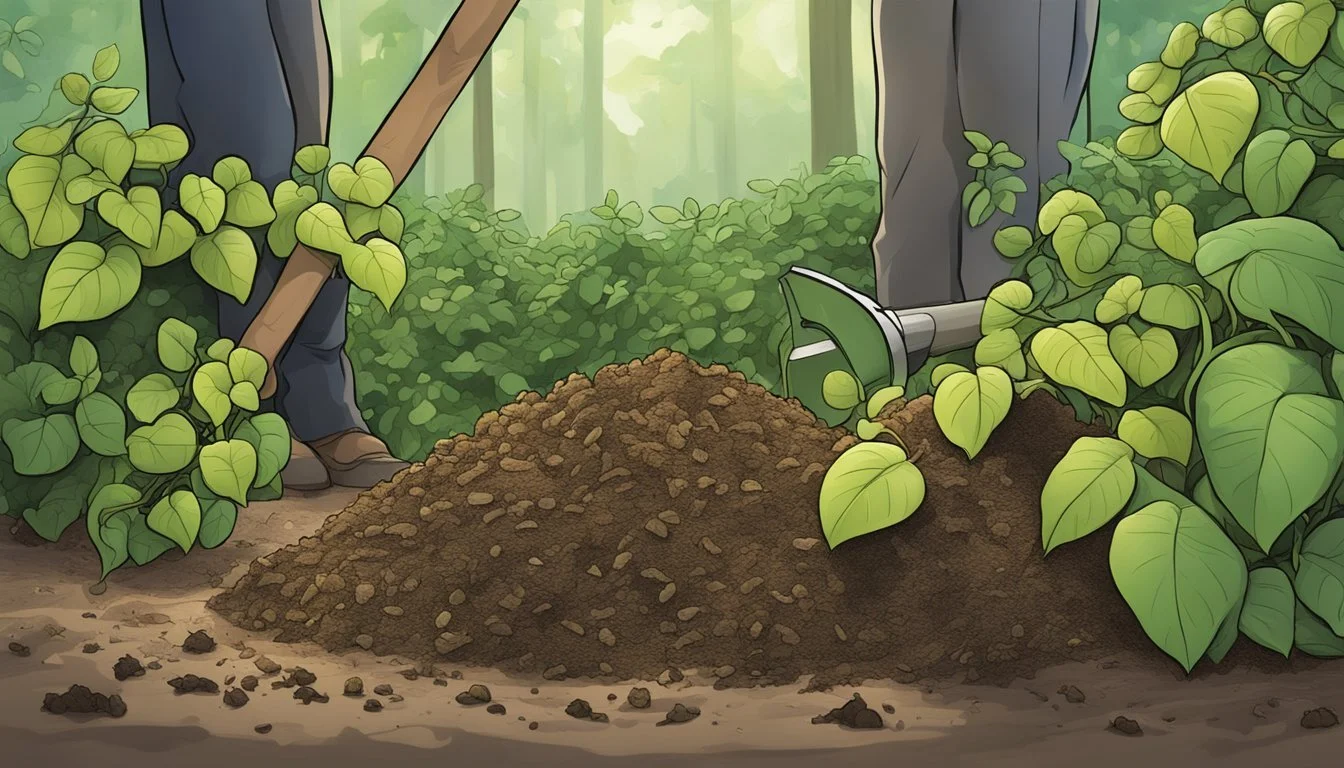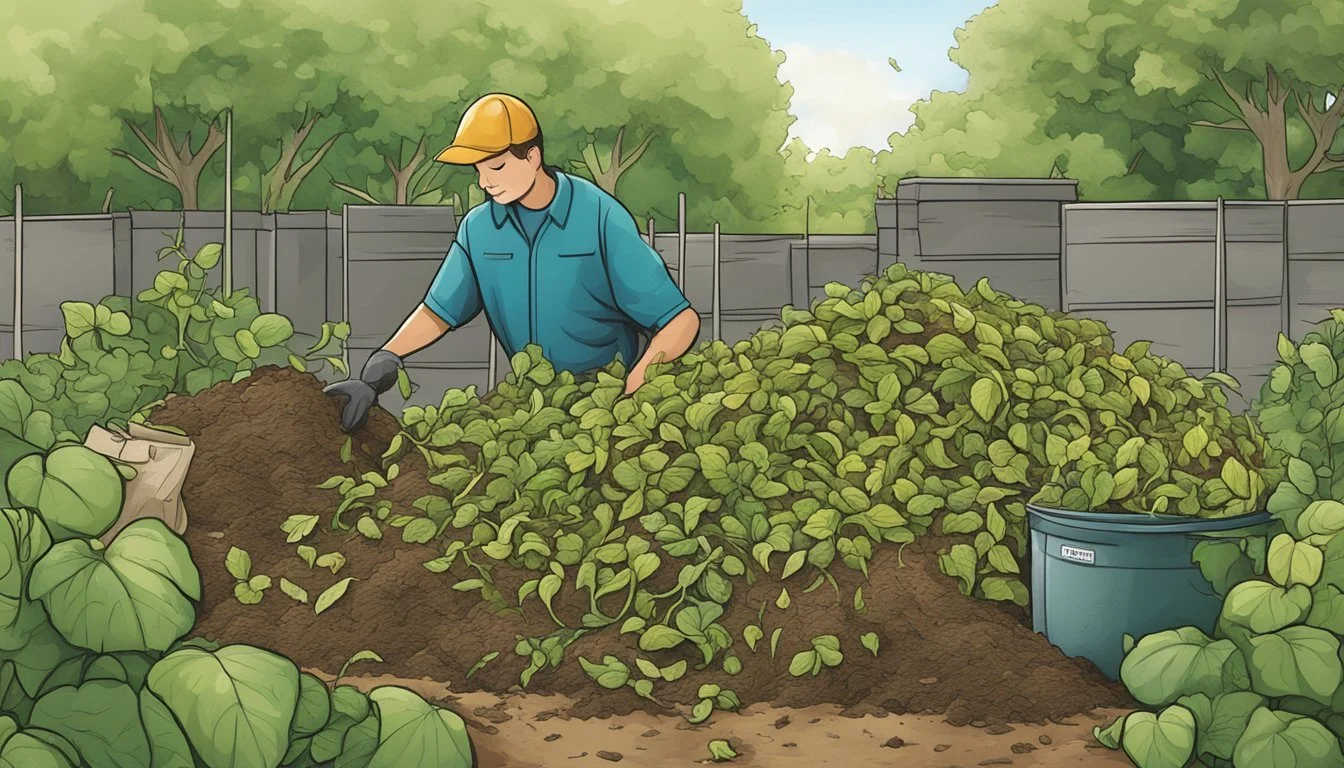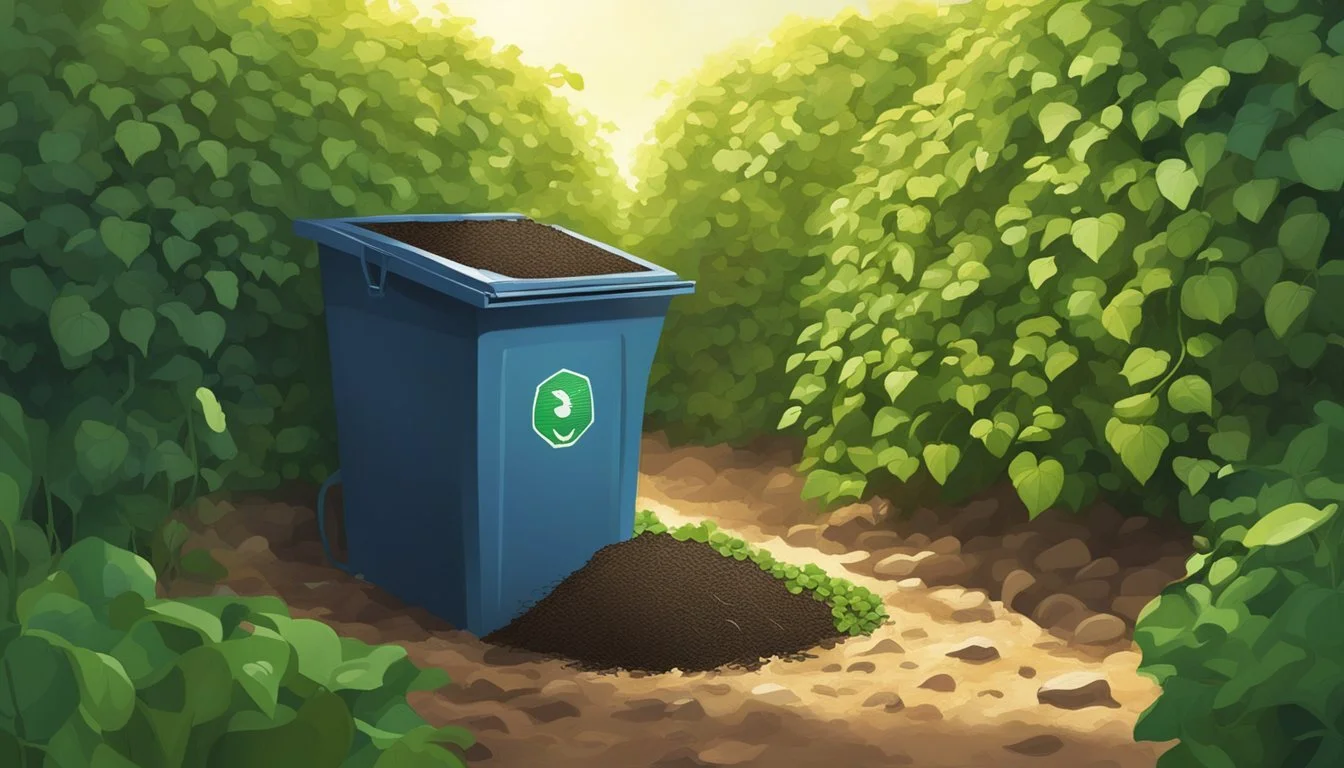Can You Compost Vines?
Understanding Vine Composting Practices
Composting is a natural process of recycling organic matter, such as leaves and food scraps, into a valuable fertilizer that can enrich soil and plants. It's an integral part of sustainable gardening, providing a myriad of benefits including waste reduction and improvement of soil structure. When it comes to composting vines, gardeners might be uncertain about their inclusion in the compost pile. Vines, given their structure and growth habits, present a unique case for compost enthusiasts.
Garden waste, particularly vines, can indeed be composted effectively. Vines, like other organic garden refuse, can break down in a compost pile to contribute to the nutrient-rich humus that benefits garden soil. However, to ensure a successful decomposition process, it's crucial for gardeners to prepare vines properly before adding them to the compost heap. This helps to avoid potential issues, like entanglement or uneven composting, which can impede the breakdown process and the overall health of the compost.
The key to composting vines is in understanding that while they are biodegradable, they require certain steps for optimal decomposition. Gardeners must consider the condition of the vines, such as whether they're diseased or contain seeds that could sprout. Proper shredding or chopping of vines can promote quicker and more uniform breakdown and integration into the compost pile. With careful consideration and handling, vines can be turned from garden waste into a valuable resource for the eco-conscious gardener.
Basics of Composting
In this section, the reader will gain a clear understanding of the essentials of composting, from defining compost, recognizing its environmental benefits, to grasping the fundamental principles needed to successfully transform organic materials into valuable soil amendments.
What Is Compost?
Compost is a nutrient-rich soil amendment produced from the aerobic decomposition of organic materials. These materials may include fallen leaves, plant debris, fruit and vegetable scraps, and other biodegradable items. The resultant substance is rich in nutrients essential for plant growth.
Benefits of Composting
Composting offers numerous benefits to the environment and garden health:
Reduces landfill waste: By composting organic material, one reduces the volume of waste sent to landfills.
Enriches soil: Compost enhances soil structure, texture, aeration, and moisture retention.
Nutrient supply: It provides a steady release of essential nutrients including nitrogen, phosphorus, and potassium.
Sustainable: Composting is a natural recycling process that reduces the need for chemical fertilizers, promoting a healthier environment.
Principles of Composting
To create compost effectively, one must manage four key elements bold:
Carbon and Nitrogen: Balancing browns (high in carbon) and greens (high in nitrogen) is crucial. A general recommended ratio is 3:1, with three parts browns to one part greens.
Browns: Leaves, straw, wood chips
Greens: Kitchen scraps, grass clippings, coffee grounds
Air: Oxygen is vital for microorganisms to thrive and break down organic material.
Water: The pile should be moist but not soaked to support the decomposition process.
Temperature: A compost pile should reach 135-160°F to effectively break down materials and kill pathogens.
Properly managing these elements accelerates the decomposition process, leading to successful compost creation.
Composting Materials
Effective composting requires a balance of materials that are categorized into greens and browns. The former provides nitrogen while the latter offers carbon, both essential for decomposition.
Green and Brown Materials
Green Materials: These items are rich in nitrogen and help to heat up the compost pile, which speeds up the process of decomposition. Examples include:
Grass clippings: High in nitrogen, excellent for composting.
Fruit and vegetable scraps: From the kitchen or a vegetable garden, these materials break down quickly.
Coffee grounds: A nitrogen-rich addition that also adds a fine texture to the compost.
Manure: Only from herbivores such as cows and chickens, contributes significant nitrogen.
Brown Materials: These carbon-rich items are necessary for absorbing excess moisture and providing aeration:
Leaves: Are one of the best brown materials; they should be dry and shredded.
Straw and hay: Excellent for structure and aeration; straw is preferable as hay may contain seed heads.
Wood chips and sawdust: Good sources of carbon but should be used sparingly due to slow decomposition.
Shredded paper towels and tissues: Add carbon and are particularly useful when greens are excess.
Hair and dryer lint can also be added in moderation as they are both high in nitrogen.
Materials to Avoid in Composting
Certain items do not belong in a compost pile because they may attract pests, cause odor issues, or contain harmful pathogens and chemicals:
Dairy products and meat: Can attract rodents and other pests, emit odors as they decompose, and possibly harbor pathogens.
Oils and fats: Similar to dairy and meat, these can attract pests and create odor problems.
Diseased plants: Risk of spreading disease through the compost.
Plastic, metal, or glass: Non-biodegradable and contaminates the soil.
Tissues and paper towels used with chemicals: Can introduce undesirable substances to the compost.
Yard waste, including vines, can be composted if they are not diseased and are chopped into smaller pieces to aid in decomposition.
Compost Pile Management
Effective management of a compost pile involves building it properly, maintaining adequate moisture and temperature, and regularly turning the pile to ensure optimal decomposition, especially for materials like vines.
Building a Compost Pile
A compost pile should be built using a balance of green nitrogen-rich materials, like vegetable scraps or vine cuttings, and brown carbon-rich materials, such as leaves or shredded paper. Bins or open piles can both facilitate hot composting, where the internal temperature rises significantly due to microbial activity, speeding up decomposition.
Maintaining Moisture and Temperature
For a compost pile to decompose effectively, it must maintain moisture levels akin to a wrung-out sponge. The internal temperature is crucial for hot composting and should ideally be between 130°F and 160°F, which can be measured with a compost thermometer. Too much or too little moisture can impede microbial activity and affect the composting process.
Turning the Compost Pile
Regularly turning the compost pile introduces necessary oxygen and evenly distributes heat and moisture. This can be done with a compost aerator or a pitchfork every few weeks. Turning accelerates decomposition, distributes decomposing vine material, and helps maintain a hot compost system by rejuvenating microbial activity.
Composting Specifics
Effective composting of garden waste not only recycles organic material but also enriches the soil. It is crucial to properly prepare plant matter, such as vines and tomato plants, to avoid introducing diseases and weeds into your compost pile. This section will guide you on safely managing these specific garden remnants.
Composting Vines
Vines, often abundant in gardens, are an excellent addition to the compost heap. Prior to composting, one should:
Chop them up: Smaller pieces decompose faster.
Ensure they are seed-free: Vines with seeds might germinate and lead to unwanted growth in your compost.
This prevents the spread of pests and pathogens and facilitates quicker decomposition.
Composting Tomato Plants
Tomato plants require careful consideration when composting due to their susceptibility to diseases like blight and fusarium wilt. To safely compost tomato plants:
Check for diseases: Only compost plants that show no signs of illness.
Remove all fruit and seeds: This limits the risk of disease and prevents tomato growth in your compost.
Composting diseased tomato plants can contaminate your compost pile with pathogens, so it is imperative to inspect them thoroughly.
Avoiding Weeds and Diseases
The integrity of your compost pile is paramount; introducing weeds or disease can be detrimental. To safeguard your compost:
Identify and remove weeds: Especially those that are seeding.
Monitor for plant diseases: Compost only healthy plant material.
Weeds can introduce invasive species or undesired plants into your garden, and diseases can be transmitted through the compost to future plantings.
Advanced Composting Techniques
In the realm of composting, advanced techniques such as Hot Composting, Composting with Worms, and Trench Composting can elevate the success and efficiency of breaking down green and brown matter into nutrient-rich compost.
Hot Composting
Hot composting is an accelerated method that relies on maintaining a balance of green and brown matter to boost microbial activity. A successful hot compost pile reaches temperatures between 135-160°F, which speeds up decomposition and kills weed seeds and pathogens. The key benefits are quicker turnaround time, typically within a few weeks, and a resultant compost rich in nutrients.
Green Matter: Includes materials like grass clippings and kitchen scraps.
Brown Matter: Includes dry leaves, wood chips, and straw.
Composting with Worms
Worm composting, or vermicomposting, introduces red wigglers or other composting worms into the composting system. Worms consume organic waste and excrete castings, which are extremely nutrient-rich and beneficial for soil health.
Benefits: Improved soil structure, enhanced microbial populations, and increased plant growth.
Considerations: The system should be kept in a temperature-controlled environment, as worms require specific conditions to thrive.
Trench Composting
Trench composting involves digging a trench in the garden and burying organic material, allowing it to decompose directly in the soil. This method works well for vines and larger plant materials that might otherwise take longer to break down in a traditional compost pile.
Process: Alternate layers of green waste with soil to encourage breakdown.
Advantage: Direct enrichment of garden soil with minimal maintenance.
By employing these techniques, gardeners can effectively manage their composting efforts, leading to an enhanced garden ecosystem.
Utilizing Compost
Compost serves as an excellent addition to garden practices, offering a nutrient-rich resource that benefits soil quality and plant health. It is an eco-friendly way to recycle yard and kitchen waste, transforming it into valuable material for various gardening undertakings.
In the Garden
In the realm of gardening, compost acts as a superior soil conditioner. When incorporated into garden soil, compost improves soil structure, enhancing its capacity to retain water and nutrients. This is especially beneficial in managing sandy soils that drain quickly and clay soils that tend to retain too much water. A notable advantage of using compost in the garden is the presence of beneficial microbes. These organisms play a crucial role in breaking down organic matter, releasing nutrients that are readily accessible to plants.
As Fertilizer
Compost can also be utilized directly as an organic fertilizer. By mixing compost into the soil, gardeners enrich the earth with essential nutrients such as nitrogen, phosphorus, and potassium, which are vital for healthy plant growth.
Nutrient Benefit in Plants Nitrogen Promotes leaf growth Phosphorus Supports development of roots and flowers Potassium Enhances overall plant health
Using compost as fertilizer not only feeds the plants but also maintains the natural cycle of nutrients within the ecosystem, reducing the need for chemical fertilizers.
For Environmental Benefits
Employing compost is an environmentally responsible choice that contributes to sustainable gardening practices. It reduces the amount of organic waste in landfills, thereby decreasing methane emissions, a potent greenhouse gas. Furthermore, compost's ability to enrich soil and foster healthy plant growth inevitably leads to a garden teeming with life, which aids in carbon sequestration, minimizes soil erosion, and helps maintain the ecological balance.
Troubleshooting Common Composting Issues
When composting vines or any organic matter, one may encounter several problems such as pest invasions, unpleasant odors, or inactivity in the compost pile. Addressing these issues promptly ensures a healthy composting process.
Dealing with Pests and Pathogens
Pests such as rodents and insects are commonly attracted to compost piles. To prevent infestation, one should:
Maintain a proper balance of green (nitrogen-rich) and brown (carbon-rich) materials.
Turn the pile regularly to disrupt the breeding cycle of pests and to maintain adequate air circulation.
Enclose the compost in a bin with a lid or use hardware cloth to deter larger pests.
For pathogens, a compost pile should reach a high temperature, generally between 135°F to 160°F, to kill harmful microorganisms. One should also avoid composting diseased plants to reduce the risk of spreading the pathogen to future plantings.
Managing Odor and Moisture Problems
Compost piles that emit a strong smell often indicate an imbalance in moisture or the type of materials being composted. To control odor and moisture:
Ensure the pile has enough brown materials, such as dry leaves or straw, to absorb excess moisture and reduce rot.
Aerate the pile by turning it, which reduces anaerobic conditions that cause foul odors.
If the pile is too dry, add water to maintain moisture levels that encourage microbial activity without causing sogginess.
Solving Compost Pile Inactivity
A compost pile may become inactive or decompose slowly due to several factors:
Temperature: Cold weather can slow down the microbial activity. Insulate the pile to retain heat.
Air: Lack of oxygen can halt decomposition. Regularly turn the pile to introduce air and reactivate the microbes.
Balance: Adjust the ratio of greens to browns to ensure the pile has the necessary nitrogen and carbon.
Optimizing these conditions encourages the efficient breakdown of compost materials, including vines, into rich soil amendment.
Composting and Sustainability
Composting plays a crucial role in enhancing sustainability by managing organic waste effectively and supporting environmental health.
Reducing Waste
By composting vines, individuals and communities can significantly reduce the volume of yard waste sent to landfills. This lessens the environmental impact as landfills emit methane, a potent greenhouse gas. Through composting, vines that might otherwise occupy landfill space are instead recycled.
Landfills Reduced: Composting could diminish the presence of organic waste in landfills.
Methane Emissions: Reducing landfill waste cuts down methane emissions.
Recycling Organic Matter
Vines are a valuable source of organic matter that, when composted, are broken down and transformed into a nutrient-rich soil amendment. This process recycles nutrients and returns them to the soil, thus enabling a circular life cycle for organic materials.
Soil Amendment: Compost improves soil health by adding organic matter.
Nutrient Cycle: It keeps the nutrient cycle ongoing by returning elements back to the earth.
Composting as a Sustainable Practice
Composting is an eco-friendly practice that augments soil fertility without relying on chemical fertilizers. This spontaneous recycling system enhances water retention, aids in nutrient delivery to plants, and fosters overall environmental sustainability.
Eco-Friendly: Composting is a natural, chemical-free process.
Soil Fertility: It contributes to the recovery and maintenance of soil fertility.
Beyond the Bin
When exploring composting options, one should consider community resources and educational materials that provide guidance beyond personal compost bins.
Community Composting
Community composting initiatives offer a solution for individuals who cannot compost at home. These programs often accept a greater variety of organic material, including vines that might not break down easily in a typical home compost bin. Individuals can contribute their yard waste to a communal pile, which is managed to attain higher temperatures, neutralizing seeds and pathogens. Local gardens, agricultural extensions, or recycling centers often facilitate such programs.
Composting Education and Resources
For those looking to expand their knowledge on composting, numerous resources are available. Education is key in mastering composting techniques. Many local extension services offer ebooks and workshops on proper composting methods, detailing which materials are compost-safe and how to manage a compost pile effectively. Additionally, online platforms provide extensive resources, including forums for sharing experiences and advice on compost-related challenges. These educational tools ensure that individuals are well-informed on how to maintain a healthy composting ecosystem, whether in a bin at home or as part of a community effort.
Conclusion
Composting vines is indeed feasible and beneficial for both gardeners and the environment. Here are the key takeaways for including vines in a compost pile:
Preparation: Before adding vines to compost, it’s critical to chop or shred them to accelerate decomposition. Composting thicker vines may require additional cutting to prevent tangling and to ensure proper breakdown.
Disease-Free: Only compost vines that are free from disease. Infected plant materials can spread pathogens throughout the compost, potentially infecting future plants.
Balance: Vines should be considered as "green" material, rich in nitrogen. They should be balanced with "brown" material, such as twigs or dry leaves, to maintain the optimal carbon-to-nitrogen ratio.
Monitoring: Keep an eye on the compost pile for adequate moisture levels and aeration. Vines, with their dense nature, should not be allowed to compact and reduce airflow.
By following these guidelines, gardeners can effectively include vines in their composting efforts, thereby repurposing this organic waste into valuable soil amendments that enrich the earth and support sustainable practices.











